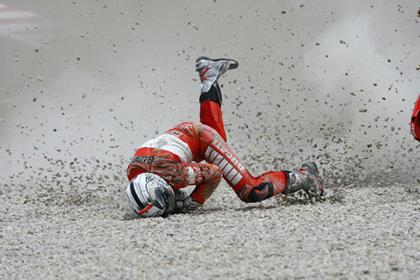Government helmet ratings panned
Government safety ratings for helmets are irrelevant because tests focus on impacts to the wrong place, according to a new report.
Testers target points on either side because they have “misinterpreted” research to conclude this is where helmets are most likely to be hit in a crash, the report claimed.
- Compare and buy motorcycle helmets
Meanwhile the area which is really most likely to be struck is ignored.
The Birmingham University report is by the chairman of the British Standard for motorcycle helmets, Dr Nigel Mills.
It affirms concerns about the Government’s Safety Helmet Assessment and Ratings Programme (SHARP) first raised in MCN last year.
SHARP awards helmets a star rating from one to five based on ability to withstand impacts in tests.
More importance is based on performance in impacts to points on either side than elsewhere because testers believe this is where more than half of real blows happen in crashes.
They claim 26% are to the left side and 27% to the right.
But those figures are taken from a study which simply divided helmets down the middle into left and right-hand portions and counted blows either side of the dividing line, according to Mills. Only blows to the very top of the helmet were excluded.
SHARP testers have misunderstood the research by taking the numbers to represent impacts to the extreme left and right-hand points, the new report says.
It suggests the underlying assumption of SHARP ratings – that helmets should be particularly able to withstand impact tests to points on either side – is completely wrong.
Mills report says research in fact shows most impacts are to the chin-bar, an area not tested by SHARP at all.
He told MCN the lack of chin-bar tests was particularly worrying because SHARP has rated flip-front helmets. “A lot of people are quite concerned that flip-front helmets don’t have the same protection at the chin,” he said.
“SHARP doesn’t test chin-bars but it has still given ratings to flip-front helmets.”
His report says it is a ‘misinterpretation of… statistics to say that 27% of impacts occur on a specific left site’.
He said: “Anything anywhere on the left-hand side is included in that 27%. It isn’t the same as saying 27% are at this specific site at the far left.”
A SHARP spokesman said: “We strongly dispute that any data was misinterpreted during the development of the SHARP rating system, which is designed to ensure that only helmets providing good levels of protection to a wide area of the head can achieve the highest ratings.
“International research, reviewed by the Transport Research Laboratory on behalf of DfT, recommended that helmets should provide improved protection to the rider’s temple as this area of the head is particularly vulnerable to injury.
“The testing carried out by SHARP encourages manufacturers to extend the helmet’s protection over this important area.”
Read the new report here: www.perg.bham.ac.uk/pdf/Critical_evaluation_SHARP.pdf
Find SHARP ratings here: sharp.direct.gov.uk


